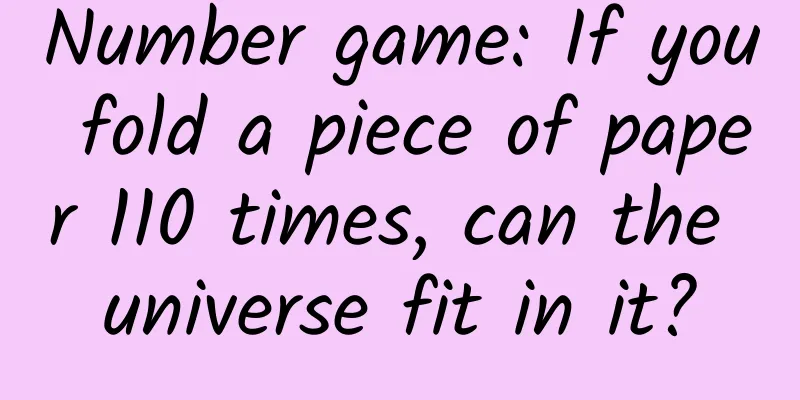Number game: If you fold a piece of paper 110 times, can the universe fit in it?

|
This is a question that is often seen on the Internet. In fact, this question is pure nonsense, but if you think about it carefully, you will find it very interesting because it can popularize some basic knowledge from different aspects, such as how big the universe is, how small matter is, and so on. I have answered such questions in the past. Since everyone is very interested in this type of question, I will talk about it from another perspective. Simply put, no matter how you fold a piece of paper, it is still that piece of paper and still has the same volume. Not to mention the universe, even a small box can hold it. This kind of problem is just a numbers game. In fact, there are two bugs in it. One is that no paper can be folded in half 110 times, or even 10 times; the second is that even if it can be folded in half, the length will increase, and the volume will remain unchanged. The universe is a huge space. The general scientific understanding is that the radius of the observable universe is 46.5 billion light years. What does radius mean? It means that the universe is roughly spherical. I won't calculate the volume, as anyone can do it with elementary school arithmetic. But the problem is that the observable universe is just the limit of the universe that scientists can observe in the future based on the expansion rate of the universe and the speed at which galaxies are moving away from us. As for how big the unobservable universe is, there is no theory to estimate it, so no one knows. Now let's assume that this piece of paper can be folded 110 times and calculate how long it is. Let us first assume that this piece of paper is an A4 paper with a length and width of 297mm*210mm. It has different thicknesses, the thinnest of which is about 1/8mm. In this way, the area of this paper is 623.7cm^2 and the volume is 7.8cm^3. In fact, someone once said that it is impossible to fold a piece of paper 7 times. It depends on how big the paper is. If it is an A4 paper, it cannot be folded 7 times, because folding it 7 times will have 64 layers, and the area of one layer of the paper is only 9.7cm^2, which is a small square with a side length of about 3cm and a thickness of less than 1cm, so it cannot be folded. But if this piece of paper is as big as a football field, can it be folded 7 times? No one has tried it, but those who are interested can give it a try. Now let’s get back to the topic. If you fold an A4 paper 110 times, how long will it be? In fact, this is a very simple calculation. The value is 2^110 layers. If each layer is folded tightly without any gaps, and the thickness of each layer is 1/8mm, then the length is about 1.6*10^26km. How long is 1.6*10^26km? The length of 1 light-year is 9.46*10^12km, so the thickness of this folded paper is about 17 trillion light-years. The radius of the observable universe is 46.5 billion light-years, so the thickness of this paper folded 110 times is 368 times the observable universe. So, can't the universe accommodate the length of this piece of paper folded in half 110 times? First of all, if this length is rigid and unbreakable, the observable universe really cannot hold it; but we don’t know how big the unobservable universe is at present, so can we hold it? We don’t know either. Secondly, if a piece of paper is really folded this long, it will definitely become a thread. How thin is this thread? We can calculate it. Simple calculation: if the thickness is fixed, the area is reduced by half every time it is folded. The area of an A4 paper is 623.7cm^2, so the area of a piece of paper folded 2^110 times is only 4.8*10-31cm^2. If this area is converted into the area of a circle, according to the formula for finding the radius from the known area of the circle, that is, the area of the circle/π=radius squared, it can be calculated that after folding this piece of paper 2^100 times, it will become a filament with a diameter of about 3.9*10^-16cm. How thin is this filament? The diameter of an atom is about 10^-8cm, the diameter of an atomic nucleus is about 10^-13cm, and the diameter of a quark is about 10^-16cm, which means that this is a filament slightly thicker than a quark. That is to say, if it were to increase by about 250 times, it would be equivalent to the diameter of an atomic nucleus, and if it were to increase by 25 million times, it would be as thick as an atom. Can such a filamentary universe be put aside? It depends on how you say it. It is a game where each has his own reasons. What do you think? Welcome to discuss, thank you for reading. The copyright of Space-Time Communication is original. Infringement and plagiarism are unethical behavior. Please understand and cooperate. |
>>: Will tap water be contaminated after heavy rain and floods?
Recommend
How to play Taobao live broadcast + private domain operation?
At 8 pm on May 24, Tmall 618 pre-sale officially ...
How can an ordinary self-media person become a marketing tycoon? Watch me subdue the dragon with eighteen moves
When I opened the backend of the official account...
Green Onion Metal Standard Edition Review: A Transformation, Two-thirds Success
The mobile phone market has long been a bloody ba...
How to become an excellent user growth operator
As a front-line user growth practitioner, what qu...
Cheetah Browser embeds Egret Runtime to expand into HTML5 mobile gaming
Discussions about HTML5 mobile games have recentl...
Why do you get burned all over when you play in the water? Keep these chemicals away from your home!
Expert of this article: Chu Yuhao, PhD of Beijing...
Three channels for App operation and promotion: online, offline and new media.
App operation is not easy, which depends on produ...
In the post-3.5mm interface era, the Vermillion Red version of Sony MDR-EX750BT calls you to recharge your faith
One of the major changes that the much-anticipate...
The mobile phone "lifespan" ranking list is released, Huawei is not in the top three, the top spot is expected
With the popularity of smart phones, more and mor...
What are the methods of product promotion?
Now that the product has reached maturity and has...
Was there air pollution in ancient times? Let’s see what the ancients said!
Copywriter: Tianlan Editorial Office Edited by: R...
21 most commonly used growth techniques by foreign growth hackers
After testing and practicing throughout 2017, for...
Bai Juyi and Du Fu were also nearsighted! Without glasses, what would the ancients do if they were nearsighted?
Planning and production Source: Minitory (ID: min...
Some Google services have been transferred back to China App Store can download Google products
[[151912]] Google Logo Although Chinese users can...









